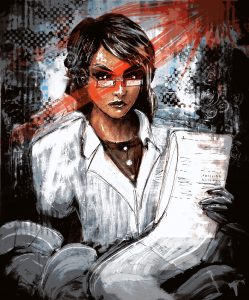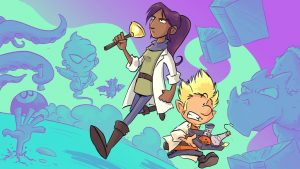A relatively quiet month. We were open for our final ever call for submissions, which resulted in a record volume of submissions. We also rolled the Summer 2019 quarterly out the door.
Archives
Categories
-
A relatively quiet month. We were open for our final ever call for submissions, which resulted in a record volume of submissions. We also rolled the Summer 2019 quarterly out the door.
 While our publication is winding down, there are plenty of other great speculative fiction publications that are still going strong. One of those, Uncanny Magazine, is currently crowdfunding their sixth year of publication, including raising their rates to pay authors more for their short fiction. Uncanny Magazine is dedicated to publishing fiction from diverse authors, and has also published Disabled People Destroy Science Fiction, with Disabled People Destroy Fantasy coming soon!
While our publication is winding down, there are plenty of other great speculative fiction publications that are still going strong. One of those, Uncanny Magazine, is currently crowdfunding their sixth year of publication, including raising their rates to pay authors more for their short fiction. Uncanny Magazine is dedicated to publishing fiction from diverse authors, and has also published Disabled People Destroy Science Fiction, with Disabled People Destroy Fantasy coming soon!
Another magazine, Strange Horizons is also crowdfunding their next year of publication, which will be their twentieth year in business! In addition to their primary magazine, Strange Horizons also publishes Samovar, which publishes English-language translations of stories that were originally published in other languages (along with the original stories). This is another magazine focused on diverse authors and new voices in the genre, also definitely worthy of your support!
A number of our MSJ alums and friends of the magazine have been published in the pages of Uncanny Magazine and/or Strange Horizons, or are otherwise involved with their publication. We’re glad to see both of these magazines flourishing, and we hope you’ll help out with their Kickstarters to ensure many more years of awesomeness from them!
 Beginning today, we’ll be interviewing some of the authors who contributed stories for I Didn’t Break the Lamp. You can learn more about the authors and their stories as we prepare to publish this anthology! Today’s interview is with Jennifer R. Povey, whose story in I Didn’t Break the Lamp marks her third anthology appearance with us!
Beginning today, we’ll be interviewing some of the authors who contributed stories for I Didn’t Break the Lamp. You can learn more about the authors and their stories as we prepare to publish this anthology! Today’s interview is with Jennifer R. Povey, whose story in I Didn’t Break the Lamp marks her third anthology appearance with us!
DV: Tell us a bit about yourself!
Jennifer R. Povey: I’m in my forties and I live just outside DC, although I grew up in the UK. (If you ask why? Course of true love is why). I ride horses and am a full-time freelance writer. Which often means writing boring stuff, but it beats working for a living. I’m a bit of a space geek and a history geek (my degree is in archaeology, which is surprisingly useful for a SF writer).
DV: What inspired you to write “The Voice” for I Didn’t Break the Lamp?
JRP: I wanted to subvert a trope. If I say which one, it will spoiler the story. But suffice to say I wanted to take a story in a direction that is seldom used.
DV: The imaginary acquaintance in “The Voice” is an unusual choice. Without giving too much of your story’s plot away, how did you decide on the characterization for the imaginary character?
JRP: It boils down to the same thing I said above. Also, the character concerned does fill an emotional gap for the MC, who has some, well, family issues going on.
DV: Your story paints a somewhat bleak image of humanity’s future, but also includes inklings of hope as well. If you were to take this story further, to the next phase that the story hints at, would it wind up with a happy or unhappy ending?
JRP: Happy. Absolutely. I know what they find in the end, even though it isn’t in the story. And it’s not a bad thing at all.
DV: What’s on the horizon for you?
JRP: Right now, I’m working on a book tentatively called Arana, which is basically a space exploration book in the grand tradition of Star Trek, if way more Enterprise than TNG. I also have a historical fantasy in the works, Arthurian based, The Lay of Lady Percival, which I’m hoping to get out there sooner.
Thanks, Jennifer!
An essay by Emilia O. Anthony, as provided by Johanna B. Stumpf
Art by Luke Spooner
I swipe my key card in front of the keypad and wait. A short beep and a small green light indicate access has been granted. A hydraulic hum sounds almost inconceivably, and the two metal doors in front of me slide aside swiftly.
My heels click sharply on the tiled floor as I enter through the doors and walk along the corridor. The neon lights on the low ceiling bathe the scene in merciless white light. On both sides of the hallway are more doors exactly like the one I just stepped through. No signs or markings. Just impenetrable steel doors with keypads to one side. I only have access to some of them, and sometimes I try to guess what might be behind the others. The projects, the experiments, the prototypes. On other days, these thoughts fill me with excitement, but today I’m not in the mood for guessing games.
My destination is the eleventh door on the left. I don’t have to count. I have been there almost every day in the last four months, and my feet carry me to the right door without a second thought.
I stop and swipe my key card absentmindedly. The door remains closed. Lost in thoughts as I am, it takes a few seconds before I realize the door won’t open. I swipe my card again. A red light blinks once on the keypad. My heart skips a beat. I try one more time, putting the key card carefully in front of the card reader. This time the light turns green and the hydraulic motors start humming. I step forward eagerly.
For a moment there, I was afraid. Afraid the experiment had been canceled and the room had been sealed off. I have seen it many times before. Once I arrived at work, only to find that the laboratory I had been working in had disappeared overnight. Well, technically, the room was still there. Had to be there. Somewhere in this building. Right next to this corridor. Deep underneath the earth. But the doors were gone. In the place where they used to be was just a plain wall. It didn’t even look new. That day I continued to walk to the next doors that would grant me access and started working on a new project behind them. I never asked anyone about the abandoned experiment. In a place like this, it is better not to ask too many questions.

For a moment there, I was afraid. Afraid the experiment had been canceled and the room had been sealed off. I have seen it many times before.
To read the rest of this story, check out the Mad Scientist Journal: Summer 2019 collection.
Emilia O. Anthony holds PhDs in electrical engineering and computer science. Unfortunately, the university recently lost all records of her studies. The fact that her birth records went missing from her hometown around the same time is completely coincidental. The loss of her dental records is entirely unrelated and has not even been noticed by her dentist yet.
Johanna B. Stumpf is a German millennial, living and working in Norway. She is fairly new to fiction writing, but she did enough academic writing to earn a PhD in computer science from the University of Oslo.
Luke Spooner, a.k.a. ‘Carrion House,’ currently lives and works in the South of England. Having recently graduated from the University of Portsmouth with a first class degree, he is now a full time illustrator for just about any project that piques his interest. Despite regular forays into children’s books and fairy tales, his true love lies in anything macabre, melancholy, or dark in nature and essence. He believes that the job of putting someone else’s words into a visual form, to accompany and support their text, is a massive responsibility, as well as being something he truly treasures. You can visit his web site at www.carrionhouse.com.
“Behind Closed Doors” is © 2019 Johanna B. Stumpf
Art accompanying story is © 2019 Luke Spooner
When filmmakers decided to make a movie of the classic Jules Verne novel 20,000 Leagues Under the Sea in 1916, they faced a few challenges in rendering the scenes from the book into film. But with the help of three inventions, they were able to create one of the iconic scenes of the film!
The first invention was a submarine tube, which allowed people to work on submarines and salvage shipwrecks while in a watertight chamber with helmets and arm casings. While not invented for the movie, it allowed for the possibility of filming underwater.
The second invention was the photosphere, which could be attached to the submarine tube and used to shoot the film.
The third, and most iconic, invention (since it actually saw screen time) was the giant cephalopod. For this, the filmmaker designed a submersible device that relied on rubber tubes and halved rubber balls to simulate tentacles.
You can read more about all three of these inventions (plus how they made the cephalopod’s ink) here!
If you’ve got younger kids who are interested in space, check out the NASA Kids’ Club! It’s full of games and information about space and NASA, geared towards kids in the primary grades (up to American 4th grade). The activities adhere to National Education Standards, and there’s a whole page that details how the activities meet those goals for individual grade levels. So you could use the activities here as part of a continued summer learning project, or, if you’re a teacher, within your curriculum.
There are both online activities and printable activities available, so no matter if you prefer your kids to have no screen time or limited screen time, there are neat options!

Martin Vorel (https://freeimage.me/photo/298754/parabolic-antenna) CC-0
Last year, we reviewed Glass and Gardens: Solarpunk Summers, which featured a number of MSJ alumni. Now, World Weaver Press is putting out Glass and Gardens: Solarpunk Winters, and once again, the table of contents is chock full of our alumni! Wendy Nikel, Holly Schofield, Steve Toase, and Jennifer Lee Rossman will all have stories in this anthology, and the editor, Sarena Ulibarri, is also an MSJ alum!
 We love graphics novels, so we were excited to find Stormhaven Techs, which is currently funding for a print graphic novel on Kickstarter!
We love graphics novels, so we were excited to find Stormhaven Techs, which is currently funding for a print graphic novel on Kickstarter!
Stormhaven Techs is about two technicians who work in the magic department at a high school for mages and knights. One of the characters has a history as an adventurer, which comes back to haunt her now and then. The comic blends humor and action into a fun romp.
If you want to get a taste of this comic, the individual issues are free here. But if you prefer reading graphic novels over web-based comics, check out the Kickstarter and see if it’s something you might like to back! It runs through August 9th with a modest goal, so check it out soon!
An essay by Decatur Scott, as provided by Shana Ross
Art by Justine McGreevy
July/August 2055
Q: What technology or scientific advancement was the biggest mistake in human history?
Carey Murphy, research and development, Kinetic Informatics
Using quantum entanglement to power garage door openers. I mean, I hate changing batteries on a transponder as much as the next guy, but it’s just irresponsible to have a remote that opens and closes the door to your house from anywhere in the universe.
Michiko Hawley, researcher and professor, Harvard University
The dolphin translator. The tech is brilliant, but it was just a bad idea. Dolphins are wicked smart, and they’re super angry, very bitter as a species. Nothing nice to say to us, about us, etc. And the thing about the translator tech is that once you’ve gone public with it, everyone knows it exists, it works … well, it’s not like you can STOP talking to the dolphins now. You’re stuck. And it just sucks to have to keep hearing, over and over, about all the awful things humanity is responsible for, and have these smug self-important fish nagging and nagging about how pod responsibility starts with individuals. It’s really damaging to your self-confidence, right? Just … ugh.
To read the rest of this story, check out the Mad Scientist Journal: Summer 2019 collection.
Decatur Scott is a science journalist with a fondness for the lost art of reporting in print media. Her first TED tweet, on the evolutionary advantages of the shrinking human attention span, won a Peabody Award. She lives in Washington, DC, where she is working on her memoir, Surviving the Robot Uprising: How, Why, and What Now. The book is for entertainment purposes only, and she cannot be held liable for any sentience or other damages that may result from downloading review copies on networked devices.
Shana Ross bought her first computer working the graveyard shift in a wind chime factory, a beloved HP whose hard drive resides in her basement with a number of early works. Her writing career has been dormant for 18 years for reasons both practical and best discussed in therapy, but she has been making a respectable living as a consultant, executive coach, and global leadership expert. In 2018, she dyed her hair purple and is starting to turn that all around. This is her first published fiction.
Justine McGreevy is a slowly recovering perfectionist, writer, and artist. She creates realities with the hope of making our own a little brighter. You can see more of her artwork and find links to connect on social media through her website justinemcgreevy.com
“In Hindsight” is © 2019 Shana Ross
Art accompanying story is © Justine McGreevy

(https://en.wikipedia.org/wiki/File:View_of_loch_lomond.JPG) CC-by-sa-2.5 (https://creativecommons.org/licenses/by-sa/2.5/)
Archaeologists studying crannogs, constructed islands in the Scottish lochs, have found evidence that suggests that these islands are far older than originally believed.
Originally, the crannogs had been dated to approximately 800 B.C. Newer investigations point to an origin of roughly 3640-3360 B.C., or more than 5,500 years ago. The crannogs are constructed from immense rocks, some of which weigh more than 550 pounds individually. The level of labor required to construct these islands points to their significance to these prehistoric peoples.
You can read a brief summary of the research here, and the full article on the research is in Antiquity (available here).